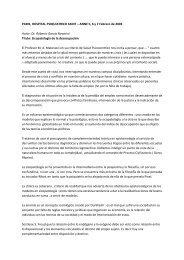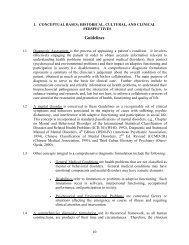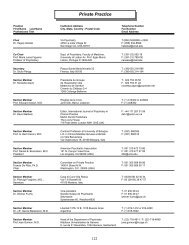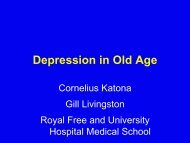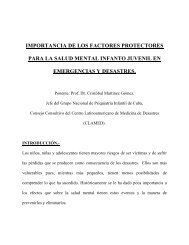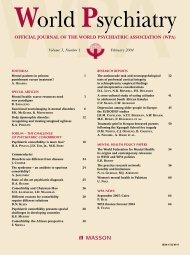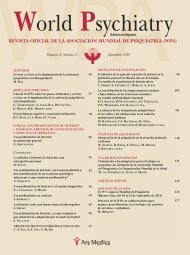ABSTRACTS - World Psychiatric Association
ABSTRACTS - World Psychiatric Association
ABSTRACTS - World Psychiatric Association
Create successful ePaper yourself
Turn your PDF publications into a flip-book with our unique Google optimized e-Paper software.
RS1.3.<br />
BRIEF INTERPERSONAL PSYCHOTHERAPY<br />
WITH A PRE-TREATMENT ENGAGEMENT SESSION<br />
FOR PATIENTS IN ROUTINE PRACTICE SETTINGS<br />
H.A. Swartz, E. Frank, N.K. Grote, A. Zuckoff<br />
University of Pittsburgh School of Medicine, Department<br />
of Psychiatry, Pittsburgh, PA; Department of Social Work,<br />
University of Washington, Seattle, WA, USA<br />
High rates of mental health treatment dropout and low rates of therapy<br />
attendance are common problems in the delivery of effective psychiatric<br />
care. These issues are especially prominent among socially<br />
disadvantaged and ethnic minority cultural groups. The authors<br />
developed a one-session intervention based on principles derived<br />
from motivational interviewing and ethnographic interviewing,<br />
designed to improve depressed patients’ participation in subsequent<br />
psychiatric treatment. This “engagement session” focuses on communicating<br />
the therapist’s understanding of patients’ individual and culturally-embedded<br />
perspectives, helping patients see how the potential<br />
benefits of treatment align with their own priorities and concerns,<br />
facilitating identification and resolution of ambivalence, and problem-solving<br />
barriers to treatment engagement. When administered in<br />
combination with a brief form of IPT (IPT-B), designed for individuals<br />
who are unlikely to remain in psychotherapy for longer durations,<br />
this approach can be used to treat depression in difficult-to-engage<br />
patient populations. In this paper, we describe the intervention itself<br />
(engagement session plus IPT-B) and present empirical data supporting<br />
its efficacy derived from two clinical trials with non-treatmentseeking<br />
patient populations: depressed mothers of children with psychiatric<br />
disorders and low-income, depressed, pregnant women<br />
receiving treatment in the obstetrics clinic of a large public hospital.<br />
We also report on our experiences training a diverse group of community<br />
mental health clinicians to deliver the engagement session<br />
and IPT-B in routine practice settings.<br />
RS1.4.<br />
ADAPTATION, TESTING AND DISSEMINATION<br />
OF GROUP INTERPERSONAL PSYCHOTHERAPY<br />
IN SUB-SAHARAN AFRICA<br />
H. Verdeli, K.F. Clougherty, M.M. Weissman<br />
Teachers College, Department of Clinical and Counseling<br />
Psychology, Columbia University; New York State <strong>Psychiatric</strong><br />
Institute, Columbia College of Physicians and Surgeons,<br />
Columbia University, New York, NY, USA<br />
Historically interpersonal psychotherapy (IPT) has been developed,<br />
adapted, tested, and disseminated in Western academic and community<br />
mental health settings. Its use in resource-poor non-Western<br />
societies had not been attempted until recently. We adapted group<br />
IPT (IPT-G) for depressed adults in southern Uganda and adolescents<br />
in internally displaced (IDP) camps in northern Uganda. These adaptations<br />
were tested in randomized clinical trials showing efficacy of<br />
IPT-G in both sites. The process of adapting and training in IPT for<br />
each site is discussed, focusing on how: local communities’ expression<br />
and experience of depression were taken into account; conceptual<br />
and technical adaptation of IPT-G were negotiated, given profound<br />
local differences in communication patterns and interpersonal/social<br />
roles from western ones; feasible and culturally meaningful<br />
IPT training and supervision of local facilitators was set up in each<br />
site; and systemic factors, such as partnerships with non-governmental<br />
organizations, local sanctioning by traditional healers, and fostering<br />
of local IPT training, facilitated the adoption of IPT-G by each<br />
local community. Following the termination of the two clinical trials,<br />
IPT-G has been disseminated in a number of provinces in Uganda and<br />
other sub-Saharan countries. A conclusion is drawn about elements<br />
of IPT that “hold constant” across our work in the USA, Europe and<br />
sub-Saharan Africa.<br />
RS2.<br />
NEW ADVANCES IN DIFFUSION MAGNETIC<br />
RESONANCE IMAGING AND THEIR APPLICATION<br />
TO SCHIZOPHRENIA<br />
RS2.1.<br />
TRENDS IN THE ANALYSIS OF DIFFUSION<br />
MRI DATA FOR GROUP STUDIES<br />
S. Peled, M. Kubicki, M.E. Shenton<br />
Brigham and Women’s Hospital and Harvard Medical School,<br />
Boston, MA; Veterans Affairs Boston Healthcare System,<br />
Brockton, MA, USA<br />
Diffusion magnetic resonance imaging (dMRI) is an MRI modality<br />
that has gained tremendous popularity over the past five years and is<br />
especially promising for imaging white matter in the brain. Diffusion<br />
imaging is one of the first methods that make it possible to visualize<br />
and to quantify the organization of white matter in the human brain<br />
in vivo. It has the potential to aid in the diagnosis and subsequent<br />
treatment of disorders of the central nervous system and is likely to<br />
have a major impact on assessment of white matter pathologies. In<br />
addition to direct clinical impact, dMRI has the potential to contribute<br />
to basic neurosciences, improving our understanding of physiological<br />
white matter development, aging, and connectivity. Extracting<br />
connectivity information from dMRI, termed “tractography’’, is an<br />
especially active area of research, as it promises to model the pathways<br />
of white matter tracts in the brain, by connecting local diffusion<br />
measurements into global trace-lines. In this paper, an overview is<br />
provided of existing tractography methods, and the strengths and<br />
weaknesses of different approaches are discussed. An overview of<br />
current methods for group studies based on dMRI are also presented,<br />
including the methods of Regions Of Interest (ROI) based statistics,<br />
voxel-based morphometry (VBM), tract-based morphometry (TBM),<br />
and tract-based spatial statistics (TBSS). In neurological studies of<br />
white matter using tractography, it is often important to identify<br />
anatomically meaningful fiber bundles. Available technologies for<br />
group studies comparing normal controls and subjects with schizophrenia<br />
are also discussed.<br />
RS2.2.<br />
NEW METHODS FOR ASSESSING WHOLE BRAIN<br />
DTI ABNORMALITIES IN SCHIZOPHRENIA<br />
M. Kubicki, U. Khan, L. Bobrow, L. O’Donnell, S. Pieper,<br />
C.-F. Westin, M.E. Shenton<br />
Brigham and Women’s Hospital and Harvard Medical School,<br />
Boston, MA; Veterans Affairs Boston Healthcare System,<br />
Brockton, MA, USA<br />
Diffusion tensor imaging (DTI), particularly new advances in DTI<br />
data processing and analysis, makes it possible to conduct a more<br />
thorough investigation of anatomical connectivity in schizophrenia.<br />
Numerous studies to-date report white matter (WM) abnormalities in<br />
schizophrenia. However, findings from these studies have been very<br />
inconsistent. Such inconsistencies are at least in part due to the differences<br />
in methodological approaches that have been used. More<br />
31




